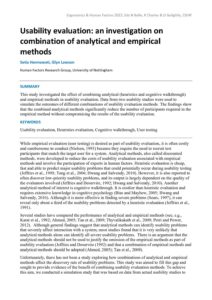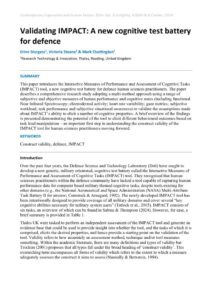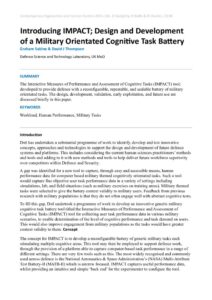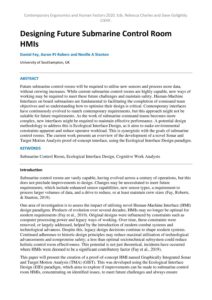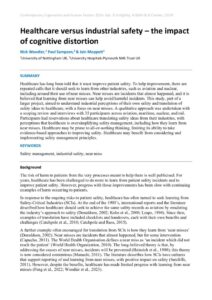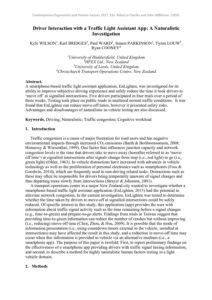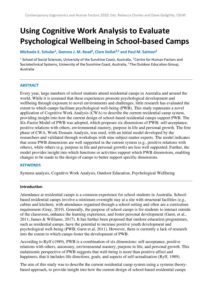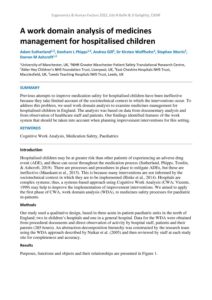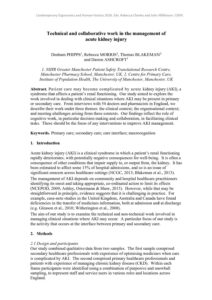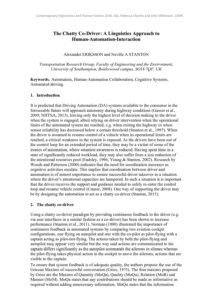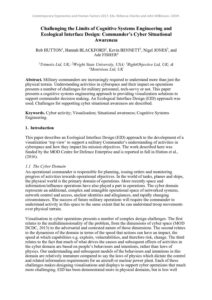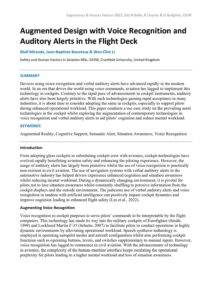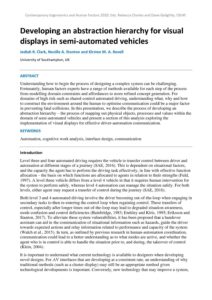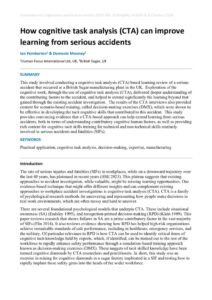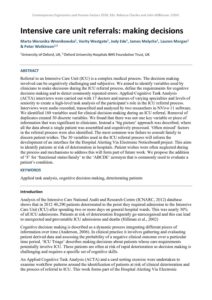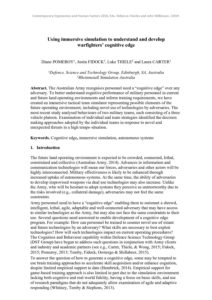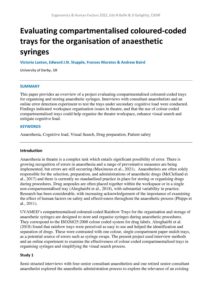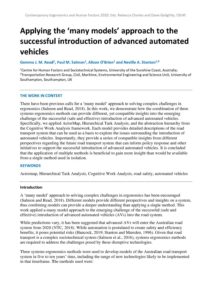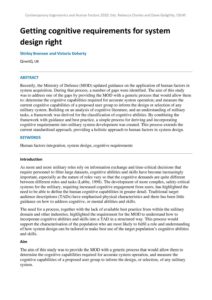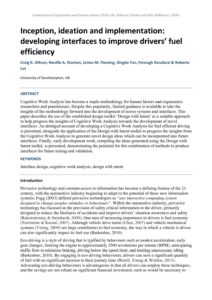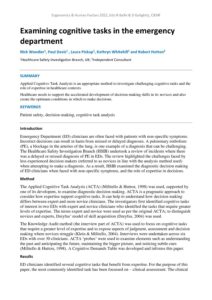Cognition
Usability evaluation: an investigation on combination of analytical and empirical methods
| Document | Author Setia Hermawati & Glyn Lawson |
| Abstract This study investigated the effect of combining analytical (heuristics and cognitive walkthrough) and empirical methods in usability evaluation. Data from two usability studies were used to simulate the outcomes of different combinations of usability evaluation methods. The findings show that the combined analytical methods significantly reduce the number of participants required in the empirical method without compromising the results of the usability evaluation. |
Validating IMPACT: A new cognitive test battery for defence
| Document | Author Erinn Sturgess, Victoria Steane & Mark Chattington |
| Abstract This paper introduces the Interactive Measures of Performance and Assessment of Cognitive Tasks (IMPACT) tool, a new cognitive test battery for defence human sciences practitioners. The paper describes a comprehensive research study adopting a multi-method approach using a range of subjective and objective measures of human performance and cognitive states (including functional Near Infrared Spectroscopy; electrodermal activity; heart rate variability; gaze metrics; subjective workload; task performance and subjective situational awareness) to validate the assumptions made about IMPACT’s ability to elicit a number of cognitive properties. A brief overview of the findings is presented demonstrating the potential of the tool to elicit different behavioural outcomes based on task load manipulation – an important first step in understanding the construct validity of the IMPACT tool for human sciences practitioners moving forward. |
Participatory Ergonomics The design of PRIME Road Markings for Motorcycle Casualty Reduction
| Document | Author Graham Sabine & David J Thompson |
| Abstract The Interactive Measures of Performance and Assessment of Cognitive Tasks (IMPACT) tool; developed to provide defence with a reconfigurable, repeatable, and scalable battery of military orientated tasks. The design, development, validation, early exploitation, and future use are discussed briefly in this paper. |
Designing Future Submarine Control Room HMIs
| Document | Author Daniel Fay, Aaron PJ Robers and Neville A Stanton |
| Abstract Future submarine control rooms will be required to utilise new sensors and process more data, without crewing increases. While current submarine control rooms are highly capable, new ways of working may be required to meet these future challenges and maintain safety. Human-Machine Interfaces on board submarines are fundamental to facilitating the completion of command team objectives and so understanding how to optimise their design is critical. Contemporary interfaces have continuously evolved to match contemporary requirements, but this approach might not be suitable for future requirements. As the work of submarine command teams becomes more complex, new interfaces might be required to maintain effective performance. A potential design methodology to address this is Ecological Interface Design, as it aims to make environmental constraints apparent and reduce operator workload. This is synergistic with the goals of submarine control rooms. The current work presents an overview of the development of a novel Sonar and Target Motion Analysis proof-of-concept interface, using the Ecological Interface Design paradigm. |
Healthcare versus industrial safety – the impact of cognitive distortion
| Document | Author Nick Woodier, Paul Sampson, & Iain Moppett |
| Abstract Healthcare has long been told that it must improve patient safety. To help improvement, there are repeated calls that it should seek to learn from other industries, such as aviation and nuclear, including around their use of near misses. Near misses are incidents that almost happened, and it is believed that learning from near misses can help avoid harmful incidents. This study, part of a larger project, aimed to understand industrial perceptions of their own safety and translation of safety ideas to healthcare, with a focus on near misses. A qualitative approach was undertaken with a scoping review and interviews with 35 participants across aviation, maritime, nuclear, and rail. Participants had reservations about healthcare translating safety ideas from their industries, with perceptions that healthcare is oversimplifying safety management, including how they learn from near misses. Healthcare may be prone to all-or-nothing thinking, limiting its ability to take evidence-based approaches to improving safety. Healthcare may benefit from considering and implementing safety management principles. |
Driver Interaction with a Traffic Light Assistant App: A Naturalistic Investigation
| Document | Author Kyle WILSON, Karl BRIDGES, Paul WARD, Simon PARKINSON, Tyron LOUW, Ryan COONEY |
| Abstract A smartphone-based traffic light assistant application, EnLighten, was investigated for its ability to improve subjective driving experience and safely reduce the time it took drivers to ‘move off’ at signalled intersections. Five drivers participated in four trials over a period of three weeks. Testing took place on public roads in unaltered normal traffic conditions. It was found that EnLighten can reduce move-off times, however it presented safety risks. Advantages and disadvantages of naturalistic in-vehicle testing are also discussed. |
Using Cognitive Work Analysis to Evaluate Psychological Wellbeing in School-based Camps
| Document | Author Michaela E. Schuler, Gemma J. M. Read, Clare Dallat and Paul M. Salmon |
| Abstract Every year, large numbers of school students attend residential camps in Australia and around the world. While it is assumed that these experiences promote psychological development and wellbeing through exposure to novel environments and challenges, little research has evaluated the extent to which camps facilitate psychological well-being (PWB). This study represents a novel application of Cognitive Work Analysis (CWA) to describe the current residential camp system, providing insight into how the current design of school-based residential camps support PWB. The Six-Factor Model of PWB was adopted, which proposes six dimensions of PWB: self-acceptance, positive relations with others, environmental mastery, purpose in life and personal growth. The first phase of CWA, Work Domain Analysis, was used, with an initial model developed by the researchers and validated through workshops with nine subject matter experts. The model indicates that some PWB dimensions are well supported in the current system (e.g., positive relations with others), while others (e.g. purpose in life and personal growth) are less well supported. Further, the model provides insight into which functions or activities support which PWB dimensions, enabling changes to be made to the design of camps to better support specific dimensions. |
A work domain analysis of medicines management for hospitalised children
| Document | Author Adam Sutherland, Denham L Phipps, Andrea Gill, Dr Kirsten Wolffsohn, Stephen Morris & Darren M Ashcroft |
| Abstract Previous attempts to improve medication safety for hospitalised children have been ineffective because they take limited account of the sociotechnical context in which the interventions occur. To address this problem, we used work domain analysis to examine medicines management for hospitalised children in England. The analysis was based on data from documentary analysis and from observation of healthcare staff and patients. Our findings identified features of the work system that should be taken into account when planning improvement interventions for this setting. |
Technical and collaborative work in the management of acute kidney injury
| Document | Author Denham PHIPPS, Rebecca MORRIS, Thomas BLAKEMAN and Darren ASHCROFT |
| Abstract Patient care may become complicated by acute kidney injury (AKI), a syndrome that affects a patient’s renal functioning. Our study aimed to explore the work involved in dealing with clinical situations where AKI may be present in primary or secondary care. From interviews with 54 doctors and pharmacists in England, we describe their work under three themes: the clinical context; the organisational context; and meeting challenges arising from these contexts. Our findings reflect the role of cognitive work, in particular decision making and collaboration, in facilitating clinical tasks. These should be the focus of any interventions to improve AKI management. |
The Chatty Co-Driver: A Linguistics Approach to Human-Automation-Interaction
| Document | Author Alexander ERIKSSON and Neville A STANTON |
| Abstract |
Challenging the Limits of Cognitive Systems Engineering and Ecological Interface Design: Commander’s Cyber Situational Awareness
| Document | Author Rob HUTTON, Hannah BLACKFORD, Kevin BENNETT, Nigel JONES, and Ade FISHER |
| Abstract Military commanders are increasingly required to understand more than just the physical terrain. Understanding activities in cyberspace and their impact on operations presents a number of challenges for military personnel, tech-savvy or not. This paper presents a cognitive systems engineering approach to providing visualization solutions to support commander decision making. An Ecological Interface Design (EID) approach was used. Challenges for supporting cyber situational awareness are described. |
Augmented Design with Voice Recognition and Auditory Alerts in the Flight Deck
| Document | Author Niall Miranda, Jean-Baptiste Bonotaux & Wen-Chin Li |
| Abstract Devices using voice recognition and verbal auditory alerts have advanced rapidly in the modern world. In an era that drives the world using voice commands, aviation has lagged to implement this technology in cockpits. Contrary to the rapid pace of advancements in cockpit instruments, auditory alerts have also been largely primitive. With such technologies gaining rapid acceptance in many industries, it is about time to consider adopting the same in cockpits, especially to support pilots during enhanced operational workload. This paper conducts a use case study on the prevailing aural technologies in the cockpit whilst exploring the augmentation of contemporary technologies in voice recognition and verbal auditory alerts to aid pilots’ cognition and reduce mental workload. |
Developing an abstraction hierarchy for visual displays in semi-automated vehicles
| Document | Author Jediah R. Clark, Neville A. Stanton and Kirsten M. A. Revell |
| Abstract Understanding how to begin the process of designing a complex system can be challenging. Fortunately, human factors experts have a range of methods available for each step of the process from modelling domain constraints and affordances to more refined concept generation. For domains of high risk such as shared-control automated driving, understanding what, why and how to construct the environment around the human to optimise communication could be a major factor in preventing fatal collisions. In this presentation, we describe the process of developing an abstraction hierarchy – the process of mapping out physical objects, processes and values within the domain of semi-automated vehicles and present a section of this analysis exploring the implementation of visual displays for effective driver-automation communication. |
How cognitive task analysis (CTA) can improve learning from serious accidents
| Document | Author Ian Pemberton & Domonic Mooney |
| Abstract This study involved conducting a cognitive task analysis (CTA) based learning review of a serious accident that occurred at a British Sugar manufacturing plant in the UK. Exploration of the cognitive work, through the use of cognitive task analysis (CTA), delivered deeper understanding of the contributing factors to the accident, and helped to extend significantly the learning beyond that gained through the existing accident investigation. The results of the CTA interviews also provided content for scenario-based training, called decision-making exercises (DMX), which were shown to be effective in developing the tacit cognitive skills that contributed to this accident. This study provides convincing evidence that a CTA-based approach can help extend learning from serious accidents, both in terms of understanding contributory cognitive human factors, as well as providing rich content for cognitive tacit skills training for technical and non-technical skills routinely involved in serious accidents and fatalities (SIFs). |
Intensive care unit referrals: making decisions
| Document | Author Marta Weronika Wronikowska, Verity Westgate, Jody Ede, James Malycha, Lauren Morgan & Peter Watkinson |
| Abstract Referral to an Intensive Care Unit (ICU) is a complex medical process. The decision making involved can be cognitively challenging and subjective. We aimed to identify variables used by clinicians to make decisions during the ICU referral process, define the requirements for cognitive decision making and to detect commonly repeated errors. Applied Cognitive Task Analysis (ACTA) interviews were carried out with 17 doctors and nurses of varying specialties and levels of seniority to create a high-level task analysis of the participant’s role in the ICU referral process. Interviews were audio recorded, transcribed and analysed by two researchers in NVivo 11 software. We identified 188 variables used for clinical decision-making during an ICU referral. Removal of duplicates created 30 discrete variables. We found that there was not one key variable or piece of information that was significant to clinicians. Instead a ‘big picture’ approach was described, where all the data about a single patient was assembled and cognitively processed. ‘Often missed’ factors in the referral process were also identified. The most common was failure to consult family to discern patient wishes. The 30 variables used in the ICU referral process will inform the development of an interface for the Hospital Alerting Via Electronic Noticeboard project. This aims to identify patients at risk of deterioration in hospitals. Patient wishes were often neglected during the process and mechanisms to address this will form part of future work. We propose the addition of ‘F’ for ‘functional status/family’ to the ‘ABCDE’ acronym that is commonly used to evaluate a patient’s condition. |
Using immersive simulation to understand and develop warfighters’ cognitive edge
| Document | Author Diane POMEROY, Justin FIDOCK, Luke THIELE and Laura CARTER |
| Abstract The Australian Army recognises personnel need a “cognitive edge” over any adversary. To better understand cognitive performance of military personnel in current and future land operating environments and inform training requirements, we have created an immersive tactical team simulator representing possible elements of the future operating environment, including novel use of technologies by adversaries. The most recent study analysed behaviours of two military teams, each consisting of a three vehicle platoon. Examination of individual and team strategies identified the decision making approaches adopted by the individual teams in response to novel and unexpected threats in a high tempo situation. |
Evaluating compartmentalised coloured-coded trays for the organisation of anaesthetic syringes
| Document | Author Victoria Laxton, Edward J.N. Stupple, Frances Maratos & Andrew Baird |
| Abstract This paper provides an overview of a project evaluating compartmentalised coloured-coded trays for organising and storing anaesthetic syringes. Interviews with consultant anaesthetists and an online error detection experiment to test the trays under secondary cognitive load were conducted. Findings indicated workspace organisation issues in theatre, and that the use of colour-coded compartmentalised trays could help organise the theatre workspace, enhance visual search and mitigate cognitive load. |
Applying the ‘many models’ approach to the successful introduction of advanced automated vehicles
| Document | Author Gemma J. M. Read, Paul M. Salmon, Alison O’Brien and Neville A. Stanton |
| Abstract There have been previous calls for a ‘many model’ approach to solving complex challenges in ergonomics (Salmon and Read, 2018). In this work, we demonstrate how the combination of three systems ergonomics methods can provide different, yet compatible insights into the emerging challenge of the successful (safe and effective) introduction of advanced automated vehicles. Specifically, we applied ActorMap, Hierarchical Task Analysis, and the abstraction hierarchy from the Cognitive Work Analysis framework. Each model provides detailed descriptions of the road transport system that can be used as a basis to explore the issues surrounding the introduction of automated vehicles. Importantly, they provide a series of compatible insights from different perspectives regarding the future road transport system that can inform policy response and other initiatives to support the successful introduction of advanced automated vehicles. It is concluded that the application of multiple methods is beneficial to gain more insight than would be available from a single method used in isolation. |
Getting cognitive requirements for system design right
| Document | Author Shirley Brennen and Victoria Doherty |
| Abstract Recently, the Ministry of Defence (MOD) updated guidance on the application of human factors in system acquisition. During that process, a number of gaps were identified. The aim of this study was to address one of the gaps by providing the MOD with a generic process that would allow them to: determine the cognitive capabilities required for accurate system operation; and measure the current cognitive capabilities of a proposed user group to inform the design or selection of any military system. Building on an analysis of cognitive literature, and an understanding of military tasks, a framework was derived for the classification of cognitive abilities. By combining the framework with guidance and best practice, a simple process for deriving and incorporating cognitive requirements into military system development was created. This process extends the current standardised approach, providing a holistic approach to human factors in system design. |
Inception, ideation and implementation: developing interfaces to improve drivers’ fuel efficiency
| Document | Author Craig K. Allison, Neville A. Stanton, James M. Fleming, Xingda Yan, Forough Goudarzi & Roberto Lot |
| Abstract Cognitive Work Analysis has become a staple methodology for human factors and ergonomics researchers and practitioners. Despite this popularity, limited guidance is available to take the insights of the methodology forward into the development of newer systems and interfaces. This paper describes the use of the established design toolkit ‘Design with Intent’ as a suitable approach to help progress the insights of Cognitive Work Analysis towards the development of novel interfaces. An abridged account of developing a Cognitive Work Analysis for fuel efficient driving is presented, alongside the application of the Design with Intent toolkit to progress the insights from the Cognitive Work Analysis to generate novel design ideas which can be incorporated into future interfaces. Finally, early development work, compiling the ideas generated using the Design with Intent toolkit, is presented, demonstrating the potential for this combination of methods to produce interfaces for future testing and validation. |
Examining cognitive tasks in the emergency department
| Document | Author Nick Woodier, Paul Davis, Laura Pickup, Kathryn Whitehill & Robert Hutton |
| Abstract Applied Cognitive Task Analysis is an appropriate method to investigate challenging cognitive tasks and the role of expertise in healthcare contexts. Healthcare needs to support the accelerated development of decision-making skills in its novices and also create the optimum conditions in which to make decisions. |

